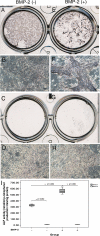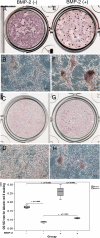Higher BMP receptor expression and BMP-2-induced osteogenic differentiation in tendon-derived stem cells compared with bone-marrow-derived mesenchymal stem cells
- PMID: 22134708
- PMCID: PMC3337107
- DOI: 10.1007/s00264-011-1417-1
Higher BMP receptor expression and BMP-2-induced osteogenic differentiation in tendon-derived stem cells compared with bone-marrow-derived mesenchymal stem cells
Abstract
Purpose: Surgical reattachment of tendon to bone often fails due to regeneration failure of the specialised tendon-bone junction (TBJ). The use of mesenchymal stem cells for TBJ regeneration has been reported with promising results. Tendon-derived stem cells (TDSCs) with high proliferative and multi-lineage differentiation potential have been isolated. As stem cells residing in tendons, TDSCs can be considered a new cell source for TBJ repair. Bone morphogenic protein 2 (BMP-2) is a potent osteogenic factor with roles in normal bone healing and pathological ectopic bone formation in soft tissues. The use of BMP-2 to promote TBJ repair has been well reported. This study aimed to compare TDSCs to the gold standard bone-marrow-derived mesenchymal stem cells (BMSCs) with respect to osteogenic response to BMP-2 in vitro.
Method: The clonogenicity and multi-differentiation potential of TDSCs and BMSCs were identified by colony-forming-unit assay, osteogenic, adipogenic and chondrogenic differentiation assays. Their osteogenic response to BMP-2 in vitro was examined by alkaline phosphatase (ALP) cytochemical staining, ALP activity assay and Alizarin red S staining of calcium nodule formation. Messenger RNA (mRNA) and BMP receptor (types IA, IB and II) protein expression were examined by quantitative real-time reverse-transcriptase polymerase chain reaction (qRT-PCR) and Western blotting.
Results: Our results showed that both TDSCs and BMSCs exhibited stem cell properties, including clonogenicity and multi-differentiation potential. TDSCs expressed higher mRNA and protein levels of BMP receptors IA, IB and II. They also exhibited higher osteogenic differentiation with and without BMP-2 stimulation compared with BMSCs.
Conclusions: TDSCs with/without BMP-2 might be an attractive source for TBJ repair compared with BMSCs.
Figures





Similar articles
-
Mechanical loading increased BMP-2 expression which promoted osteogenic differentiation of tendon-derived stem cells.J Orthop Res. 2011 Mar;29(3):390-6. doi: 10.1002/jor.21218. Epub 2010 Sep 29. J Orthop Res. 2011. PMID: 20882582
-
Comparison of potentials of stem cells isolated from tendon and bone marrow for musculoskeletal tissue engineering.Tissue Eng Part A. 2012 Apr;18(7-8):840-51. doi: 10.1089/ten.TEA.2011.0362. Epub 2011 Dec 13. Tissue Eng Part A. 2012. PMID: 22011320 Free PMC article.
-
Bone morphogenetic protein receptor in the osteogenic differentiation of rat bone marrow stromal cells.Yonsei Med J. 2010 Sep;51(5):740-5. doi: 10.3349/ymj.2010.51.5.740. Yonsei Med J. 2010. PMID: 20635450 Free PMC article.
-
Tendon-derived stem cells (TDSCs): from basic science to potential roles in tendon pathology and tissue engineering applications.Stem Cell Rev Rep. 2011 Nov;7(4):883-97. doi: 10.1007/s12015-011-9276-0. Stem Cell Rev Rep. 2011. PMID: 21611803 Review.
-
[Mechanism research progress of tendon-derived stem cells in reconstruction of fibrocartilage zone at bone-tendon junction].Zhongguo Xiu Fu Chong Jian Wai Ke Za Zhi. 2017 Aug 15;31(8):1006-1009. doi: 10.7507/1002-1892.201612078. Zhongguo Xiu Fu Chong Jian Wai Ke Za Zhi. 2017. PMID: 29806442 Free PMC article. Review. Chinese.
Cited by
-
Tendon Stem/Progenitor Cells and Their Interactions with Extracellular Matrix and Mechanical Loading.Stem Cells Int. 2019 Oct 13;2019:3674647. doi: 10.1155/2019/3674647. eCollection 2019. Stem Cells Int. 2019. PMID: 31737075 Free PMC article. Review.
-
No healing improvement after rotator cuff reconstruction augmented with an autologous periosteal flap.Knee Surg Sports Traumatol Arthrosc. 2019 Oct;27(10):3212-3221. doi: 10.1007/s00167-019-05384-8. Epub 2019 Apr 15. Knee Surg Sports Traumatol Arthrosc. 2019. PMID: 30989274
-
Effect of autologous platelet-rich plasma on the chondrogenic differentiation of rabbit adipose-derived stem cells in vitro.Exp Ther Med. 2015 Aug;10(2):477-483. doi: 10.3892/etm.2015.2528. Epub 2015 May 28. Exp Ther Med. 2015. PMID: 26622340 Free PMC article.
-
Enhanced Osteogenic Differentiation of Human Primary Mesenchymal Stem and Progenitor Cultures on Graphene Oxide/Poly(methyl methacrylate) Composite Scaffolds.Materials (Basel). 2020 Jul 5;13(13):2991. doi: 10.3390/ma13132991. Materials (Basel). 2020. PMID: 32635603 Free PMC article.
-
TGF-β Family Signaling in Mesenchymal Differentiation.Cold Spring Harb Perspect Biol. 2018 May 1;10(5):a022202. doi: 10.1101/cshperspect.a022202. Cold Spring Harb Perspect Biol. 2018. PMID: 28507020 Free PMC article. Review.
References
-
- Rodeo SA, Arnoczky SP, Torzilli PA, Hidaka C, Warren RF. Tendon-healing in a bone tunnel. A biomechanical and histological study in the dog. J Bone Joint Surg Am. 1993;75:1795–1803. - PubMed
-
- Liu SH, Panossian V, al-Shaikh R, Tomin E, Shepherd E, Finerman GA, Lane JM (1997) Morphology and matrix composition during early tendon to bone healing. Clin Orthop Relat Res 253–260. - PubMed
-
- Ivkovic A, Marijanovic I, Hudetz D, Porter RM, Pecina M, Evans CH. Regenerative medicine and tissue engineering in orthopaedic surgery. Front Biosci (Elite Ed) 2011;3:923–944. - PubMed
-
- Lim JK, Hui J, Li L, Thambyah A, Goh J, Lee EH. Enhancement of tendon graft osteointegration using mesenchymal stem cells in a rabbit model of anterior cruciate ligament reconstruction. Arthrosc. 2004;20:899–910. - PubMed
Publication types
MeSH terms
Substances
LinkOut - more resources
Full Text Sources
Other Literature Sources
Medical
Research Materials

